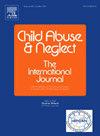Exploring the relationships between complex post-traumatic stress disorder and depression symptoms in the context of childhood maltreatment through network analysis
IF 3.4
2区 心理学
Q1 FAMILY STUDIES
引用次数: 0
Abstract
Background
Individuals with a history of childhood maltreatment commonly experience the co-occurrence of complex post-traumatic stress disorder (CPTSD) and depression, but the underlying mechanisms of their comorbidities remain unclear.
Methods
We recruited 2740 college students, including 1366 who experienced childhood maltreatment to assess the co-occurrence network of CPTSD and depression symptoms. We constructed a Gaussian graphical model to visualize the associations between symptoms and a directed acyclic graph to explore inferred relationships among symptoms.
Results
(1) We identified the following five subnetworks within the co-occurring network of CPTSD and depression symptoms: post-traumatic stress disorder (PTSD), disturbance in self-organization (DSO), depression with vegetative symptoms, depression with interpersonal problems, and lack of positive affect subnetworks. (2) Core symptoms, identified by their high expected influence, such as sadness, low spirits, and not feeling loved have the highest EI in the depression subnetwork, whereas failure, distant, avoiding clues, and avoiding thoughts have the highest EI in the DSO and PTSD subnetworks. Bridging symptoms in the childhood maltreatment network included failure, self-denial, startlement, and hyperactivity. (3) The inferred mechanism identified includes PTSD activating DSO, which subsequently triggers depression in the childhood maltreatment network.
Limitations
This study involved a non-clinical sample.
Conclusion
Our study contributes to a deeper understanding of the mechanisms of CPTSD and depression co-occurrence at a transdiagnostic level and has implications for better clinical interventions targeting influential symptoms.
通过网络分析探讨儿童虐待背景下复杂创伤后应激障碍与抑郁症状的关系。
背景:有童年虐待史的个体通常会同时出现复杂的创伤后应激障碍(CPTSD)和抑郁症,但其合并症的潜在机制尚不清楚。方法:招募2740名大学生,其中1366名曾遭受童年虐待的大学生,评估ptsd与抑郁症状的共现网络。我们构建了一个高斯图形模型来可视化症状之间的关联,并构建了一个有向无环图来探索症状之间的推断关系。结果:(1)在CPTSD与抑郁症状共发生的网络中,我们确定了以下五个子网络:创伤后应激障碍(PTSD)、自组织障碍(DSO)、植物性抑郁、人际关系问题抑郁和缺乏积极情绪子网络。(2)在抑郁子网络中,以高期望影响为特征的核心症状(如悲伤、情绪低落、感觉不到被爱)的EI最高,而在DSO和PTSD子网络中,以失败、疏远、回避线索和回避想法的EI最高。儿童虐待网络中的桥接症状包括失败、自我否定、惊吓和多动。(3) PTSD激活DSO, DSO随后触发儿童虐待网络中的抑郁。局限性:本研究涉及非临床样本。结论:我们的研究有助于在跨诊断水平上更深入地了解CPTSD和抑郁症共发的机制,并对更好地针对有影响的症状进行临床干预具有指导意义。
本文章由计算机程序翻译,如有差异,请以英文原文为准。
求助全文
约1分钟内获得全文
求助全文
来源期刊

Child Abuse & Neglect
Multiple-
CiteScore
7.40
自引率
10.40%
发文量
397
期刊介绍:
Official Publication of the International Society for Prevention of Child Abuse and Neglect. Child Abuse & Neglect The International Journal, provides an international, multidisciplinary forum on all aspects of child abuse and neglect, with special emphasis on prevention and treatment; the scope extends further to all those aspects of life which either favor or hinder child development. While contributions will primarily be from the fields of psychology, psychiatry, social work, medicine, nursing, law enforcement, legislature, education, and anthropology, the Journal encourages the concerned lay individual and child-oriented advocate organizations to contribute.
 求助内容:
求助内容: 应助结果提醒方式:
应助结果提醒方式:


